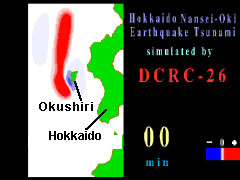How do earthquakes generate tsunamis?
Tsunamis can be generated when the sea floor abruptly deforms and vertically displaces the overlying water. Tectonic earthquakes are a particular kind of earthquake that are associated with the earth's crustal deformation; when these earthquakes occur beneath the sea, the water above the deformed area is displaced from its equilibrium position. Waves are formed as the displaced water mass, which acts under the influence of gravity, attempts to regain its equilibrium. When large areas of the sea floor elevate or subside, a tsunami can be created.
Large vertical movements of the earth's crust can occur at plate boundaries. Plates interact along these boundaries called faults. Around the margins of the Pacific Ocean, for example, denser oceanic plates slip under continental plates in a process known as subduction. Subduction earthquakes are particularly effective in generating tsunamis.

 This simulation (2 MB) of the 1993 Hokkaido earthquake-generated tsunami, developed by Takeyuki Takahashi of the Disaster Control Research Center, Tohoku University, Japan, shows the initial water-surface profile over the source area and the subsequent wave propagation away from the source. Areas in blue represent a water surface that is lower than the mean water level, while areas in red represent an elevated water surface. The initial water-surface profile, as shown in this image, reflects a large, long uplifted area of the sea floor lying to the west (left) of Okushiri Island, with a much smaller subsided area immediately adjacent to the southwest corner of Okushiri.
This simulation (2 MB) of the 1993 Hokkaido earthquake-generated tsunami, developed by Takeyuki Takahashi of the Disaster Control Research Center, Tohoku University, Japan, shows the initial water-surface profile over the source area and the subsequent wave propagation away from the source. Areas in blue represent a water surface that is lower than the mean water level, while areas in red represent an elevated water surface. The initial water-surface profile, as shown in this image, reflects a large, long uplifted area of the sea floor lying to the west (left) of Okushiri Island, with a much smaller subsided area immediately adjacent to the southwest corner of Okushiri.




 This simulation (2 MB) of the 1993 Hokkaido earthquake-generated tsunami, developed by Takeyuki Takahashi of the Disaster Control Research Center, Tohoku University, Japan, shows the initial water-surface profile over the source area and the subsequent wave propagation away from the source. Areas in blue represent a water surface that is lower than the mean water level, while areas in red represent an elevated water surface. The initial water-surface profile, as shown in this image, reflects a large, long uplifted area of the sea floor lying to the west (left) of Okushiri Island, with a much smaller subsided area immediately adjacent to the southwest corner of Okushiri.
This simulation (2 MB) of the 1993 Hokkaido earthquake-generated tsunami, developed by Takeyuki Takahashi of the Disaster Control Research Center, Tohoku University, Japan, shows the initial water-surface profile over the source area and the subsequent wave propagation away from the source. Areas in blue represent a water surface that is lower than the mean water level, while areas in red represent an elevated water surface. The initial water-surface profile, as shown in this image, reflects a large, long uplifted area of the sea floor lying to the west (left) of Okushiri Island, with a much smaller subsided area immediately adjacent to the southwest corner of Okushiri.


